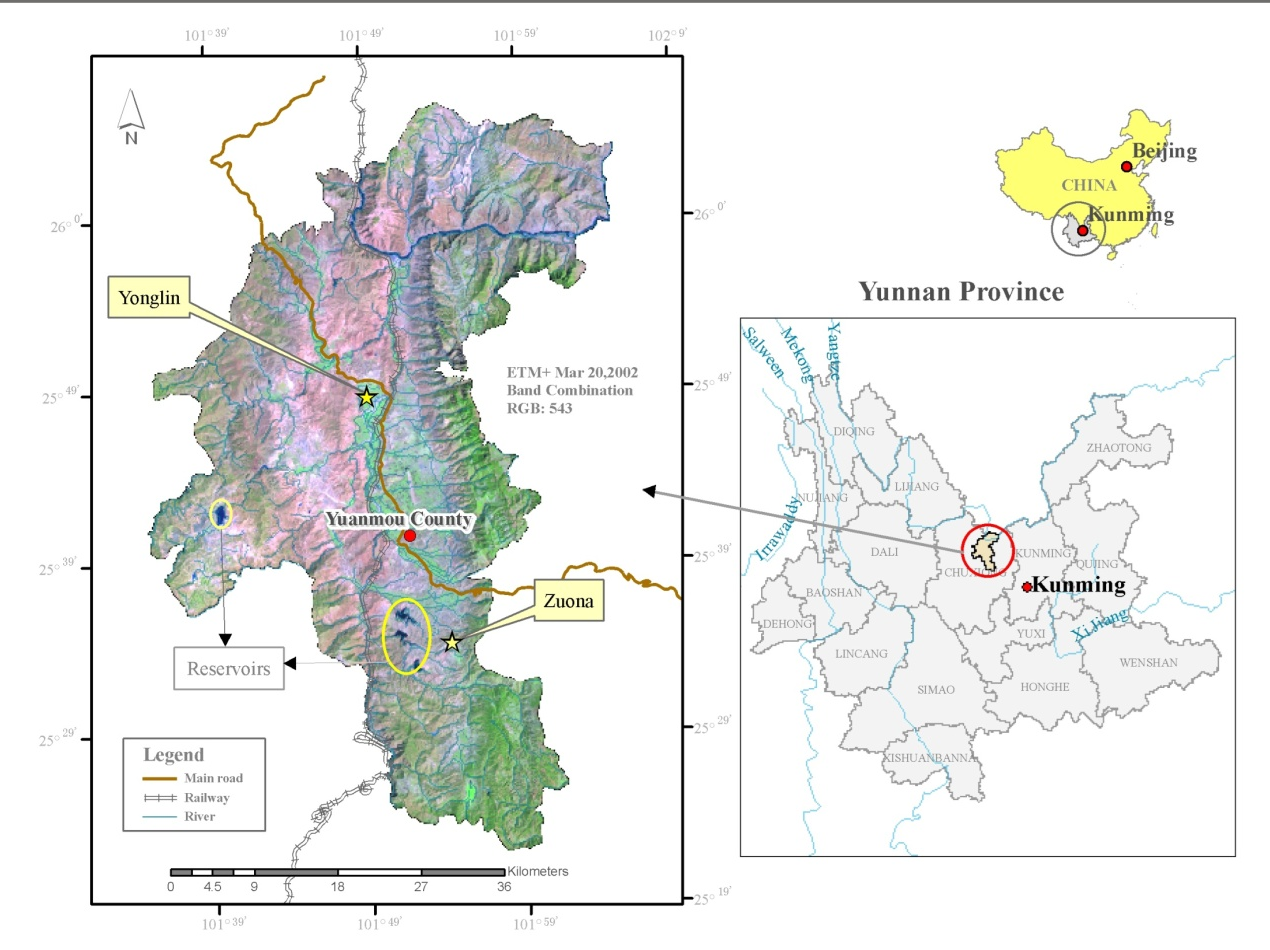Ecological profile (altitude; rainfall; evaporation; average temperature; forest coverage etc): Yuanmou is a dry-hot river valley surrounded by mountains with low annual precipitation (618.7mm) and greater annual evaporation (3911 mm). The altitude in this county varies from 900 meters to 2800 meters above sea level. The annual average temperature is 21.9 centigrade and the forest coverage in this county was 5.2% in 1985 and it went up to 12% in 2004 and 35.6% in 2010.
Demographic profile (number of population; sex ratio of the population; urban and rural ratio; ethnicities of the population; education level of the population etc): Yuanmou has a population of 215,795 living in 63,133 households at the end of 2009, of which rural population 191,226 and urban population 24,569. Han people account for 61.4% and minority groups account for 38.6%. The birth rate is 9.45 per thousand and the death rate is 5.78 per thousand with a natural growth rate of 3.67 per thousand. The sex ratio is 103.8:100 (male: female).
Socioeconomic profile (GDP; average income of people; major livelihoods and economic staples etc): farmers’ annual income in 2010 was 4783 Yuan (around $735.84). Agriculture, mainly vegetables and fruits plantation, is the main economic activity in this county and winter season vegetable plantation has been decided by the county government as the main economic development strategy for this county since 1980s.
Governance and administrative structure: there are 10 townships, 79 administrative villages and 636 natural villages in this county. Township is the lowest level of government in China with the basic structure of various line ministries and service delivery units. Administrative villages have the so-called “village self-governance structure”: village committee.
Social service systems (health care system; agricultural extension system; veterinary service system; education system): like in many other counties in China, Yuanmou County has all social service systems such as health care, education, agriculture extension etc.
Cultural aspect (religion; customs and cultural related): there is no strong religion believers in this county, but local people have some customs, for example, all family slaughter pigs and or donkeys during Chinese new year and they hold feasts for relatives and guests. This activity usually lasts for almost one month. Figure 1 shows the location of Yuanmou County.

Figure 1: location of Yuanmou County
1.2 Major health and environmental or ecosystem issues/problems in this site
l Increasing prevalence of chronic none communicable diseases such as hypertension, diabetes, heart disease, and road accidents etc.
l Infectious diseases: some decreases such as malaria and measles, some remain the same such as hepatitis A and B, and some are increasing such as STD, HIV/AIDS.
l Water-borne diseases: dysentery is the top reported infectious disease in the county; Typhoid and paratyphoid can be found all year around; cholera, was found in some remote areas; Fluorosis remains in villages where fluoride is high in the environment
l Water shortage and stress, and massive using of ground water.
l Massive use of pesticide and chemical fertilizers in agricultural production
l Poor quality of drinking water in some villages
l Lack of sewage system and waste water collection and treatment facilities
l Lack of garbage collection and treatment
l New problems of bio-gas: breeding sites of mosquito and flies and safety issue of small children
1.3 Prior research experience in this site
There are some researches done from the physical geography perspective in Yuanmou County or nearby areas that studied the geographic features of this dry-hot river valley. During 2006-2010, we conducted an EcoHealth research in this county under the IDRC funded project entitled “land use change and human health in eastern Himalayas: an adaptive ecosystem approach”, in which we conducted scoping study to understand the land use change and health problems in this county, and late on we narrowed down to focus on IPM, water and sanitation and fluorosis control.
Previous EcoHealth project has established good relationship between the research team in Kunming and local collaborators such as the County CDC and the County Health Bureau. Moreover, the findings in previous project indicated: 1) the local government took measures to control and eradicate the use of high toxic pesticides in 2001 and in 2003 the county was recognized by the Ministry of Agriculture, China as one of the 100 demonstration counties in China that produces “no-harmful” vegetables. Since then the county government has been promoting the production of “green vegetables” and wants to upgrade its products from “A level green vegetables” to “AA level green vegetables”. Although the main motivation behind this policy of local government is to increase the competitive capacity of its vegetable products on market so as to generate more financial revenue, it brought benefit to the health of both people and ecosystem. 2) The analysis of inpatient records in the county hospital during 1985-2003 reveals that poisoning patients accounted for 1.5% of all inpatient cases, of which 44.4% were pesticide poisoning. Although this is not a population-based data, still the declining trend of pesticide poisoning cases in this hospital reflects the effects of controlling the using of high toxic pesticides in this county. 3) The county government also introduced IPM and other bio-methods to control pests through cooperation with international and national organizations such as FAO. However, the new generation of pesticides that claim being high effective, low toxic and low residue are actively promoted by the agricultural extension department and are widely used by local farmers. Although the poisoning case of these new pesticides is rare, their chronic poisoning and long time implications for human health and ecosystem is not very clear due to lacking of research. Therefore, it is urgent to develop a research to monitor, document and analyze the health and environment impact of these new pesticides. Besides, the residues of old generation of pesticides can stay in the environment for a long time and continue to have impact on human health even if it is stopped using. Thus, research is badly needed to monitor and prevent the adverse impact of those pesticides.
A new goal and three entry points were identified at the end of that project, namely building Yuanmou an EcoHealth demonstration county (the goal) by working in three mutually linked entry areas: water and sanitation; food safety and nutrition; and reducing pesticide use and the associated health risks by improving and promoting IPM and health education (entry points).












